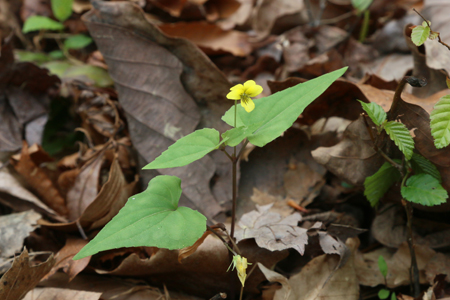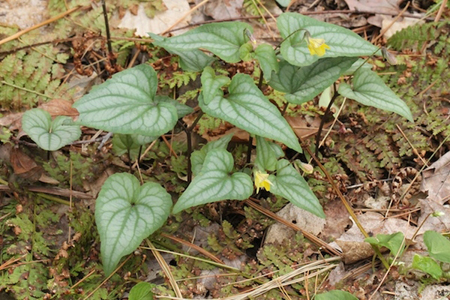Viola hastata Michx.
Common names:
Halberd-leaved Violet, Silver-leaved Violet, Spear-leaved Yellow Violet
Synonyms:
Viola hastata Michx., Fl. bor.-amer., ed. 1, 2: 149. 1803. TYPE: USA, North or South Carolina, In montibus altioribus Carolinae, [no date], A. Michaux s.n. (HOLOTYPE: MNHN-P-P04643826 [refers to the whole sheet of three separate collections], the upper left plant; isotype: MNHN-P-P04643848 [Richard Herbarium]; internet images!).
Description:
Caulescent perennials from thick whitish rhizome, stems erect, solitary (very rarely 2), ≤ 30 cm tall; stems, foliage and peduncles pale gray-green, upper surface of leaf blades frequently bicolorous or "variegated" with silvery-green lamina between the constrasting darker green veins, glabrous throughout or the upper leaf blade surface with short appressed hairs; leaves usually cauline only (occasionally with one basal leaf), clustered in upper 1/5 of shoot; stipules free, shallowly incised with 2–5 short processes especially on longer side; leaves spreading, leaf blades undivided, largest ≤ 86 × 58 mm, narrowly or broadly ovate-triangular to hastate, base subcordate to deeply cordate with basal lobes parallel or divergent, margins serrate at widest point, shallowly serrate to subentire distally, eciliate, apex acuminate; chasmogamous flower ≤ 12 mm; calyx glabrous, eciliate; lowest sepals lanceolate, sharply acute; auricles short and entire, not elongating in fruit; corolla wholly yellow with purple-brown tinge on back of petals; spur short-globose, barely exserted beyond auricles; lateral petals densely bearded with slightly clavate hairs, spurred petal glabrous; cleistogamous flowers produced after chasmogamous; capsule 7–9 mm, dark green drying brown, unspotted, glabrous; seeds 2.0–2.5(3.5) × 1.3–1.6(2.0) mm, brown, unspotted; 2n=12.
Similar species:
This caulescent species is unique in its long hastate leaf blades, which are often bicolorous ("variegated") on the upper surface with the gray- or silvery-green lamina separating the darker green veins. With its solitary stem, few or no basal leaves, and long leaf blades, this species could only be mistaken for V. glaberrima, but differs from that in the hastate leaf blades with short but deeply cordate base, and the frequently "variegated" upper surface. The variegated leaf blades are an unusual feature shared with V. hirsutula and V. villosa in subsect. Borealiamericanae, and V. walteri in subsect. Rostratae.
Ecology:
Rich rocky or sandy loam in somewhat acidic dry-mesic to mesic forests, cove and bluff forests, and bases of rock ledges.
Distribution:
Primarily Appalachian Mountain highlands and associated uplands but extending southward to Gulf Coast area, s. NY and ne. OH south to c. SC, FL panhandle and se. MS.
Rarity:
None.
Phenology:
Chasmogamous flower March–May, chasmogamous fruit May–June, cleistogamous fruit June–August.
Affinities:
This species belongs to the Yellow Violet lineage, sect. Chamaemelanium Ging., in the Nudicaules species group.
Hybrids:
None.
Comments:
This distinctive species has been accepted without controversy in all Violaceae treatments and floras, including Brainerd (1921b), Brainerd Baird (1942), Fernald (1950), Henry (1953a), Alexander (1963), Russell (1965), Strausbaugh and Core (1978), Gleason and Cronquist (1991), Ballard (2000), McKinney and Russell (2002), Weakley et al. (2012), and Little and McKinney (2015). Nevertheless, specimens are not infrequently confused with V. glaberrima or V. tenuipes, and less often with V. eriocarpa, when the whitish rhizome, conspicuous hastate leaf blades with parallel or divergent basal lobes, and frequently bicolorous or "variegated" upper surface of the blades are ignored. Despite debate over whether the species occurs in Florida, a number of herbarium specimens and online images (misidentified as “V. tripartita” sensu lato or as “V. tripartita var. glaberrima”) support its occurrence there.
Literature Cited:
Alexander, E. J. 1963. Violaceae. In Gleason, H. A., The new Britton and Brown illustrated flora of the northeastern United States and adjacent Canada. Hafner Publishing Co., Inc., New York, NY. 552-567.
Ballard Jr., H. E. 2000. Violaceae. In Rhoads, A. (ed.). Flora of Pennsylvania. University of Pennsylvania Press, Philadelphia, PA. 700-710.
Brainerd, E. 1921b. Violets of North America. Vermont Agricultural Experiment Station Bulletin 224: 1–172.
Brainerd Baird, V. 1942. Wild violets of North America. University of California Press, Berkeley, CA.
Fernald, M. L. 1950. Violaceae. In Gray’s Manual of Botany, 8th ed. American Book Company, New York, NY. 1022-1042.
Gleason, H. A. and A. Cronquist. 1991. Violaceae. In Manual of vascular plants of northeastern United States and adjacent Canada, 2nd ed. New York Botanical Garden, Bronx, NY. 157-163.
Henry, L. K. 1953a. The Violaceae in western Pennsylvania. Castanea 18(2): 37-59.
Little, R. J., and L. E. McKinney. 2015. Violaceae. In Flora of North America: Cucurbitaceae to Droseraceae, 106. Oxford University Press, New York, NY.
McKinney, L. E., and N. H. Russell. 2002. Violaceae of the southeastern United States. Castanea 67: 369–379.
Russell, N. H. 1965. Violets (Viola) of the central and eastern United States: An introductory survey. Sida 2: 1-113
Strausbaugh, P. D. and E. L. Core. 1978. Violaceae. In Flora of West Virginia, 2nd ed. Seneca Books, Inc., Morgantown, WV. 644-658.
Weakley, A. S., J. C. Ludwig, and J. F. Townsend. 2012. Violaceae. In Flora of Virginia. BRIT Press, Fort Worth, TX. 963-975.

Chasmogamous flowering habit by Bruce Sorrie

Chasmogamous flowering habit by Bruce Sorrie

Leaves during chasmogamous flower by Dan Nydick, "North Carolina Extension Gardener Plant Toolbox" website under Creative Commons license NC 2.0

Leaves during chasmogamous fruit by Suzanne Caldwell, "North Carolina Extension Gardener Plant Toolbox" website under Creative Commons license NC 2.0

Chasmogamous flower front view by Cathie Bird, "North Carolina Extension Gardener Plant Toolbox" website under Creative Commons license NC 2.0

Map by the Biota of North America Program